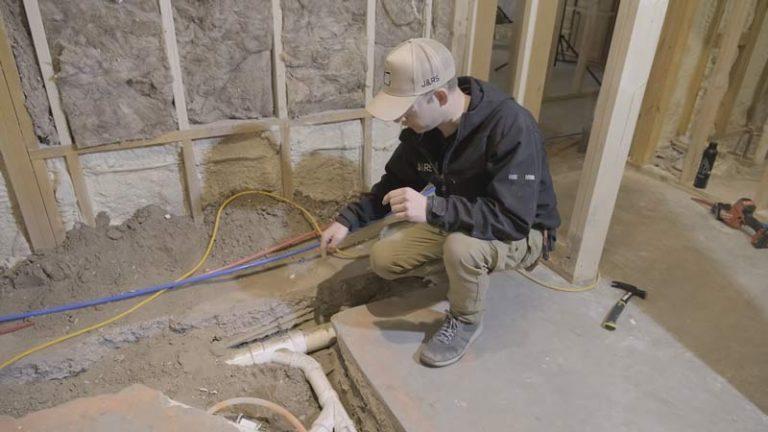Moving an Underground Gas Line: Don’t Dig Until You Read This
You have the perfect spot for a new pool, a sprawling deck, or a beautiful home addition. There’s just one problem: a buried gas line is sitting right where you need to build. This common roadblock can bring an exciting project to a screeching halt, leaving you wondering if your plans are even possible. For many homeowners, the thought of altering a utility line is intimidating, and for good reason—natural gas is not something to be taken lightly.
Ignoring a gas line or attempting to work around it without the proper knowledge is a recipe for disaster. The risks range from costly project delays to catastrophic accidents. This is not a simple weekend DIY project; it’s a complex task that demands professional expertise, strict adherence to safety codes, and meticulous planning. But with the right approach, moving that underground gas line is entirely manageable, ensuring your project can move forward safely and successfully.
You'll Learn About
The Unseen Dangers: Why This Is Not a DIY Job
Before considering any other step, it is crucial to understand the immense risks involved with natural gas. Natural gas is highly flammable and explosive. A single mistake during excavation or pipe relocation can lead to a gas leak, which can have devastating consequences. Improperly handled lines can result in fires, explosions, property destruction, and serious injury or even death.
Beyond the immediate explosive threat, natural gas exposure poses significant health risks, including carbon monoxide poisoning. Furthermore, undertaking this work without the proper permits and professional qualifications is illegal in most areas. It can lead to substantial fines, void your homeowner’s insurance, and create immense legal liability in the event of an accident. There is no scenario where a DIY approach to moving a gas line is safe or advisable.
Step 1: The Pre-Move Safety Protocol
Safety and compliance are the cornerstones of a successful gas line relocation. Before a single shovel of dirt is moved, a series of critical steps must be taken. This initial phase is all about planning, communication, and getting the right people involved. Rushing this stage is a common mistake that leads to dangerous and expensive outcomes.
Think of this as the foundation of your project. You must coordinate with utility companies and local authorities to ensure every action is documented, approved, and performed to the highest safety standards. This isn’t just red tape; it’s a proven system to prevent accidents and ensure the long-term integrity of your gas service.
Call 811: The First and Most Important Step
Before any digging occurs, you must call 811. This is a federally mandated national service that contacts local utility companies to mark the approximate location of their underground lines on your property. This service is free and is the law. Digging without calling 811 is not only reckless but can also result in significant financial penalties if you damage a utility line.
Once you call, utility locators will visit your property within a few days to mark gas, electric, water, and communication lines with flags or spray paint. This visual guide is essential for your contractor to plan the excavation safely. Remember that these markings are an estimate; careful hand-digging is often required when working close to a marked line.
Consult Your Gas Company and a Licensed Plumber
After you know where the existing lines are, the next step is to contact your local gas utility provider. They own the line running from the street to your gas meter, and any modification to this service line must involve them directly. They will provide specific procedures, costs, and timelines for their part of the work.
Simultaneously, you must hire a licensed and insured plumber or a qualified gas line contractor. These professionals are certified to work on the gas piping on your property (from the meter to your appliances). They will be responsible for the physical relocation, ensuring all new piping, fittings, and connections meet strict local and national safety codes. Be sure to verify their license and ask for references for similar projects.
The Gas Line Relocation Process: A Professional’s Guide
Once the initial safety protocols are complete and you have a qualified professional on board, the physical process of moving the gas line can begin. This is a multi-stage process that requires precision, specialized tools, and a deep understanding of gas piping systems. Each step is designed to ensure a safe, leak-free, and durable installation.
Planning the New Route and Acquiring Permits
Your licensed plumber will work with you to map out the safest and most efficient new route for the gas line. This plan must consider factors like proper burial depth, clearance from other utilities like electrical or water lines, and avoidance of future obstructions like tree roots or building foundations. Proper planning prevents future conflicts and costly re-work.
With a plan in place, your contractor will submit the necessary drawings and documentation to your local building department to obtain a permit. An inspector will review the plan to ensure it complies with all codes before work can commence. Skipping this step is illegal and can halt your entire construction project. Many homeowners wonder about the cost to trench electric line as well, and the permitting process shares many similarities.

Excavation, Installation, and Critical Testing
After the permit is approved, the careful work begins. The gas supply is shut off at the meter, and the existing line is safely purged of any residual gas. The contractor then excavates a new trench, ensuring it meets the required depth—typically 18 to 24 inches below grade, though local codes may vary.
The new pipe, usually made of durable polyethylene (PE) or corrosion-protected steel, is laid in the trench. A critical, often overlooked component for PE pipes is the installation of a tracer wire alongside the pipe. This conductive wire allows the non-metallic pipe to be located with electronic equipment in the future, a vital safety feature.
Once the new line is connected, it undergoes a crucial pressure test. The line is filled with air or nitrogen to a specified pressure and monitored with a gauge for a set period (often 15 minutes or more). If the pressure holds steady, the line is certified leak-free. A perceptible drop in pressure indicates a leak that must be found and fixed before proceeding. A final inspection by the city or county is required to approve the work before the trench is backfilled.
Understanding the Costs of Relocating a Gas Line
The cost of moving an underground gas line can vary significantly based on several factors. It’s important to get a detailed quote from your contractor that breaks down all anticipated expenses. On average, homeowners can expect to pay between $15 and $25 per linear foot, with total project costs often ranging from a few hundred to several thousand dollars.
Be aware of what is and isn’t included in the estimate. Does the price include permits, inspection fees, and the cost of repairing any landscaping or hardscaping that was disturbed during excavation? Clarifying these details upfront can prevent unexpected fees later on. Considering a project like constructing a driveway over a gas line involves similar planning and cost considerations.
| Cost Component | Typical Price Range | Notes |
|---|---|---|
| Permit Fees | $50 – $500 | Varies widely by municipality. Your contractor typically handles the application. |
| Licensed Plumber/Contractor Labor | $75 – $150 per hour | This is the largest portion of the cost. The total depends on project complexity. |
| Excavation/Trenching | $4 – $12 per linear foot | Costs can be higher for difficult soil conditions or hand-digging requirements. |
| Materials (Pipe, Fittings, Tracer Wire) | $5 – $15 per linear foot | Depends on the type and diameter of the pipe required. |
| Gas Company Fees | Varies | Applicable if the utility provider needs to shut off service at the main or move the meter. |
| Inspection Fees | $100 – $400 | Required by the local building authority to approve the work. |
| Landscape/Hardscape Repair | $200 – $2,000+ | Cost to repair lawns, patios, or driveways disturbed during trenching. Often not included in the base quote. |
Beyond the Basics: Advanced Safety Considerations
While hiring a professional is the most critical safety step, an informed homeowner can ask the right questions to ensure the highest standards are met. Understanding a few advanced concepts demonstrates a commitment to safety and helps you vet your contractor’s expertise. These are the details that separate a standard job from a truly professional and secure installation.
Material Integrity and Corrosion Protection
The type of pipe used and how it’s protected are paramount for long-term safety. While modern PE pipe is naturally resistant to corrosion, steel pipe requires specific protection. Galvanized coating is not sufficient for underground use. Steel gas pipes must have a factory-applied coating and often require cathodic protection, which uses an electrical current to prevent corrosion.
Furthermore, the backfill used in the trench is important. If the soil is rocky, the trench should be lined with sand or fine gravel to create a protective bed for the pipe. This prevents sharp rocks from damaging the pipe’s coating or the pipe itself over time as the ground settles. Issues like a rusted gas line are often a result of improper initial installation and protection.
The Importance of Electrical Grounding and Separation
Gas pipes are metallic and can become energized by lightning or accidental contact with an electrical line, creating a severe fire and shock hazard. This is why proper electrical grounding your gas meter and the entire piping system is a critical safety code requirement. Your contractor must ensure the gas system is correctly bonded to your home’s main electrical ground.
Additionally, maintaining proper separation between underground gas and electric lines is vital. Codes specify minimum distances to prevent electrical interference and reduce the risk of an electric line fault damaging the gas pipe. In case of any suspected issues, knowing who is responsible for repairs, as in a gas leak at meter: who pays? situation, often comes down to which side of the meter the problem occurs on.
Conclusion: A Project Built on Safety and Expertise
Moving an underground gas line is a serious undertaking that sits at the intersection of your home improvement dreams and critical public safety. While it may seem like a hurdle, it is a manageable task when approached with the right process and professional team. From the initial 811 call to the final inspection, every step is designed to protect your home, your family, and your community.
Never underestimate the dangers of natural gas or overestimate your ability to handle it. The financial cost of hiring a licensed, insured professional is insignificant compared to the potential cost of an accident. By investing in expertise, you are not just rerouting a pipe; you are ensuring your project is built on a foundation of safety, compliance, and peace of mind.



